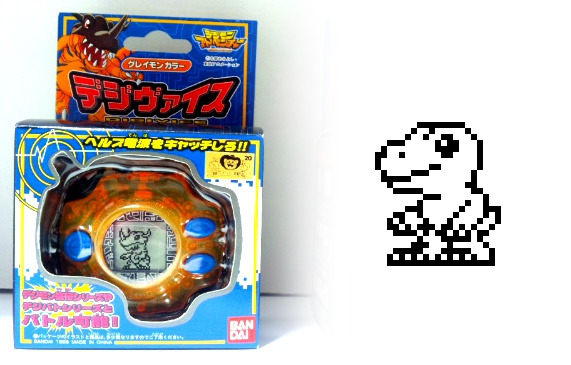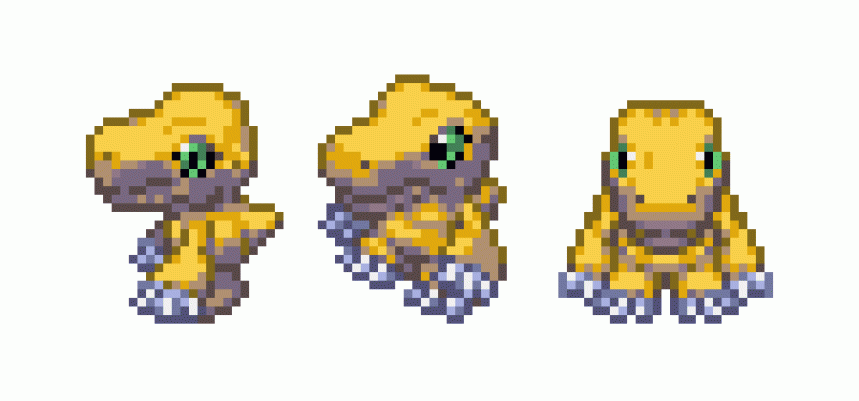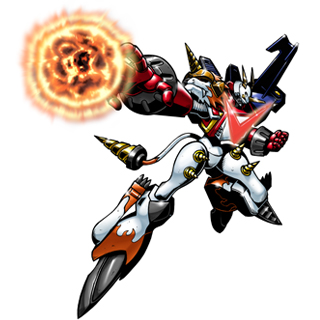Palworld is stirring some old sandbox arguments again, with kids going on about how their favourite monster battling and raising series is better than the other. Some find monsters in their pockets better, some would rather venture on the File Island. Then again, some like making monsters out of music CD data, so everyone has their own kinks. However, a strange argument about Digimon predating Pokémon pops up surprisingly often, but when asked no source is provided.
To look at the history of things, let’s start with Pokémon. If Bulbapedia and Helix Chamber are anything to go by as sources, Game Freak pitched Capsule Monsters at Nintendo in 1990. The main source of inspiration has been Satoshi Tajiri’s own childhood, with bug collecting and Ultraseven’s Capsule Monsters probably being the main points. Helix Chamber’s research on how Pokémon’s attacks were developed seem to indicate that the game was first inspired by how team member monsters battled in the first SaGa game. Somewhere down the like more elements were introduced and how attacks worked went under renovation, something the game did multiple times before it was split into Red and Green versions and released on 27th of February 1996.
I admit, I’m not versed on the developmental history of Tamagotchi. Aki Maita and Akihiro Yokoi are the two people coined to have developed the concept for Bandai. However, Yokoi seems to be the originator of the concept, as he was the founder of WiZ, a company that handled toy development and planning. According to a 1997 New York Times article, he was inspired by an ad where a kid couldn’t bring his pet turtle on a vacation. Hence, a virtual pet. The original proposal for Tamagotchi seems to have been made in 1995, which was about a mobile pet in the form of a wrist watch rather than a keychain creature raising simulator.
Aki Maita worked at Bandai and helped to solidify Tamagotchi’s concepts into its final form. At its release in 23rd of November 1996, Maita was cited as the creator of Tamagotchi for PR reasons, though Yokoi as the brains behind the original pitch was publicized with the release of the first Digital Monster V-Pet in 26th of June 1997.
The names associated with Digital Monster are Makoto Kitagawa and Kenji Watanabe. While the two WiZ employees were working on the spec documents for the second generation of Tamagotchi, they had discussed about the concept for a raising simulator for boys. WiZ would then pitch Digimon to Bandai in 1996.
All this can be skimmed for various wikis and such, but as we know, anyone can edit wikis and hey don’t necessarily have factual info. As it was with Digital Monster article, which had it stating that the Digimon franchise started in 1993, despite even the cited source putting it into 1997. This was very recently changed, so somebody noticed and changed it. You can still see the typo being mentioned in the History page. So, at some point someone had put 1993 instead of 1997 into the article, which probably was the source of many people citing Digimon as the older franchise.
If you’re taking anything out of this post, let it be never to trust Wikipedia. Hell, the original typo for 1993 seems be based on a citation for a PlayStation Life article, that is citing Gematsu’s article that was linking to the original source; Premium Bandai webstore page for the 20th anniversary release of the original V-pet. These things trigger my monomania, making me want to find something else I can put more trust on.
So, let’s disregard all those wikis and my tangents. We can find the original release date for Pocket Red and Green at the official Japanese site for the series, which supports the 1996.27.2 date. It was Tuesday.
TBS News’ story from 2021, dates the original Tamagotchi release to 1996.11.23. I’ll have to use this as a supplementary, as Bandai’s official history page for Tamagotchi doesn’t mention the day. Their history page for Digimon does have the original release date of 1997.06.26.
Now that we’ve stablished the original Japanese release dates, going back to the original argument what came first is now solved with one reason why some people might’ve been citing Digimon as a 1993 release. There are few more reasons I can think why people could make this mistake, but the dates discussed here are the original Japanese releases.
For the North American market, both Tamagotchi and Digital Monster both arrived before Pokémon. Bandai’s 1998 press release cites Tamagotchi’s US release date to be December 1st, 1997 and states the nationwide release of DigiMon happening on 10th of February 1998. Toys R Us got to pre-sell them in December 5th 1997. The press release is adamant on calling both the first virtual pet and virtual monster, which seems a pre-emptive tactic against Pokémon’s future arrival.
Pokémon Red and Blue wouldn’t hit the NA market until September 28th, 1998. We can nab the European release date for Red and Blue from the Nintendo 3DS Virtual Console store page, with the date being May 10th, 1999.
Trying to pin down the original release dates for the European version of Tamagotchi and Digital Monster is a bit more challenging, as Bandai or fans don’t seem to care about the Old World. However, based on news articles I’ve seen tonight, Tamagotchi hit European markets in 1997 and DigiMon followed after it in 1998. Nintendo didn’t handle the European markets all that well in the 1980s and 1990s, so Bandai could easily take advantage of the three-year period it took for the original Pokémon to arrive. I distinctly remember reading a newspaper article about the monster collecting wars from a tabloid, which stated that Bandai had more years under its belt as the maker of monster raising simulators. Might be a false memory though.
So, inferring from this I’ll say that some people are correct that Tamagotchi and Digital Monster are older than Pokémon in terms of release dates in North America and Europe. Kids don’t really go to look for original Japanese release years of their games and toys, and most adults don’t give a shit. If you never go look into the history of things, it’s understandable that personal recollection might conflict with factuality. Naturally this would also lead YouTubers and podcaster people using their personal recollections rather than double-checking facts, which perpetuate the misunderstanding.
An element that pops up with the bitching which one came first almost always comes with some arguments about Digimon being a ripoff of Pokémon or vice versa. Some people throw Tamagotchi in there as a catch-all to predate it further, but as we’ve seen from the dates, all three are a bit too close to be directly inspired by the competitor/ sister series.
Pokémon’s six-years long development cycle didn’t coincide with Digimon in no manner, and Tamagotchi was pitched at Bandai the same year Pocket Monsters was revealed to the public in Japan, with the trademark filing date being September 11th, 1995. Pokémon would have a later filing date of August 9th, 1996. You can find these on J-Plat Pat with Registration numbers 4245696 and 4097791 respectively. All this is to illustrate that neither Tamagotchi nor Digimon had any effect on how the original Pokémon games were forming up. However, I can’t say the same about Digital Monster taking a thing from Pokémon, but entertaining these ifs is iffy at best, and a useless exercise at worst. However, the scopes between the three were completely different in 1997. Pokémon offered an extensive world and 150 monsters to collect and train while both Tamagotchi and Digital Monster had a smaller scale experience with emphasize on pet care. Frankly, Bandai’s virtual pets were steamrolled by the Pocket Monsters in the end.
However, I am going to entertain the idea that Bandai wanted their product on the world stage first and took advantage of the longer localization process Pokémon demanded.
I haven’t appeased my original source of my momentary monomania though. I haven’t found articles that maintain Digimon as the older franchise. Maybe all it took was that one Wikipedia article’s typo to mislead people. Though I’m sure if I looked harder into old newspaper articles I’d find a bunch of them. However, as I mentioned, I’ve read these articles myself, but that might be something I’m misremembering. I did find one market salesmen mentioning how Tamagotchi was a passed fad with the arrival of Pokémon from a 2000 news article, but that’s not scratching the itch.
Though it’s funny how I can find a lot of new articles in one newspaper about Tamagotchi being a useless toy, and then selling out nationwide in the same month from 1997, only to be followed by a news article a couple of months later Marion Caspers-Merk from Germany stating how Tamagotchi was becoming a little devil and an environmental danger. Unsurprisingly, the first news regarding Pokémon is about the shock episode Electric Soldier Porygon caused. One of the best ways to describe Digital Monster I saw about digital Darwinism. Pokémon, at least as a game, seems to have made Bandai’s two raising sims obsolete as they landed in the Western shores. Market realities rarely care which series we find personally preferable.
I may not have satisfied myself about finding any source that would’ve claimed Digimon predating Pokémon. It feels anti-climatic if all it takes is one typo. At least I learned that Japanese costumed hero live-action shows had a genre name in the US in the wake of Power Rangers circa 1994; cyber-socky.

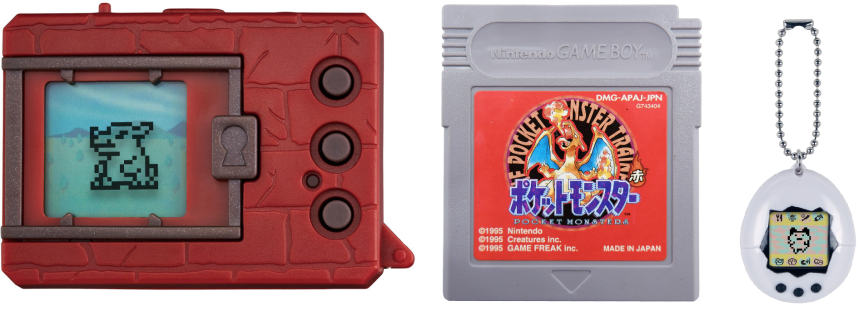



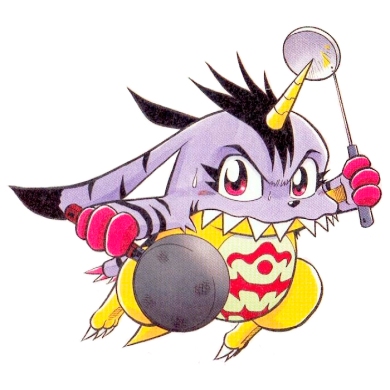

















 During the production of the Digital Monster toy, sprites were drawn first, followed up with drawn artwork. Only the most basic shapes are recognisable, and they’re so-so as well. The sprite has a big head, but with what looks like a beak. It has quite small arms as well, and no tail can be seen. With the first prototype drawing his head and feet are already fairly similar to his final design, but he’s not as menacing. A friendly upright standing crocodile that lost its tail.
During the production of the Digital Monster toy, sprites were drawn first, followed up with drawn artwork. Only the most basic shapes are recognisable, and they’re so-so as well. The sprite has a big head, but with what looks like a beak. It has quite small arms as well, and no tail can be seen. With the first prototype drawing his head and feet are already fairly similar to his final design, but he’s not as menacing. A friendly upright standing crocodile that lost its tail.





